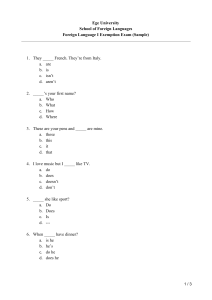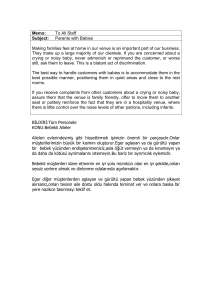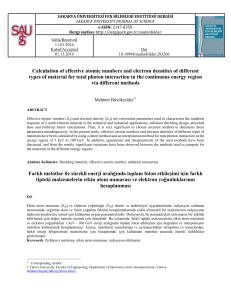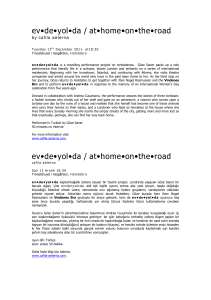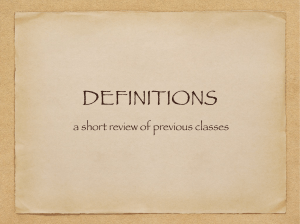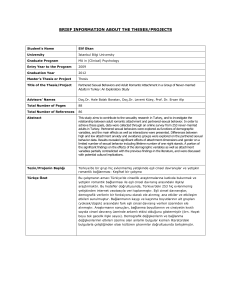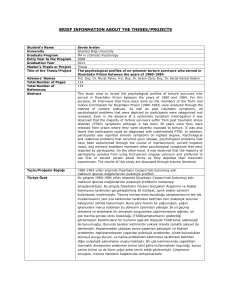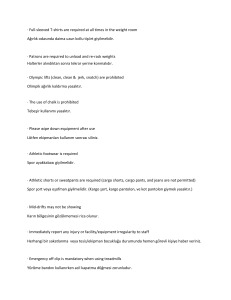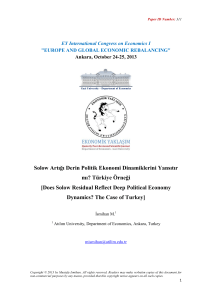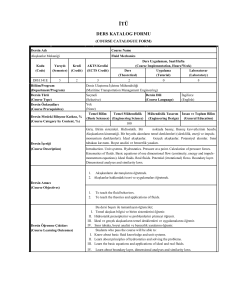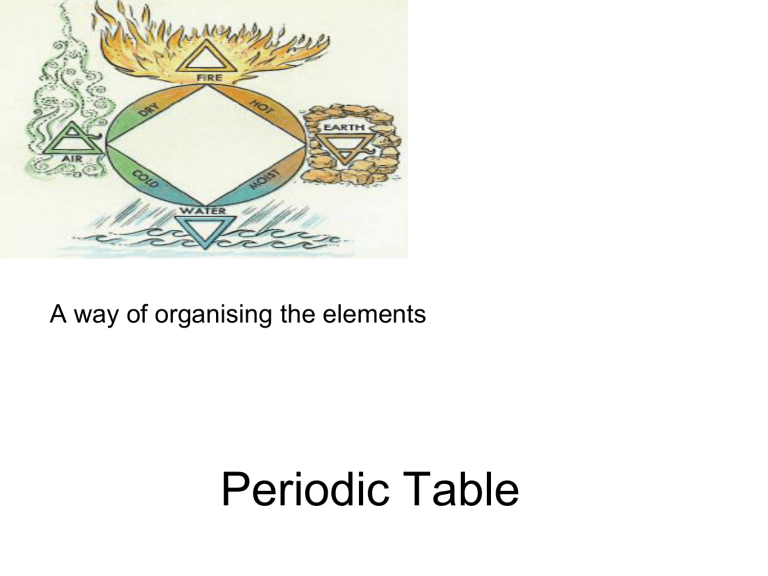
A way of organising the elements
Periodic Table
•
1828 Berzelius introduce letters to symbolize elements.
•
1829 Döbereiner devoloped “triads” groups of three elements with similar
properties. Cl – Br - I, (the properties of Br are between Cl and I) Ca – Sr - Ba
Li-Na-K
•
1864 Newlands arranged the known elements (around 60) in order tof
atomic weights and observed similarities between the first and ninth
elements, the second and tenth elements etc
•
1869 Lothar Mayer ve Dmitri Mendeleyev produced their periodic tables
simultaneously
•
1896 William Ramsay discovered the noble gases.
•
1913 Henry Moseley, determined the atomic number of each of the
elements.
Mendeleyev Periyodik Tablosu
•
Produced a table based on atomic weights and arranged periodically with elements
with similar properties under each other. Left gaps for unknown elements and
predicted their properties.
Modern Periyodik Tablo
•
•
•
•
Elements are arrangednin the order of increasing atomic numbers and there is a periodic
repitition of these elements.
The basis of the periodic table is the electron configurations of the elements.
Each horizontal row is called a a period.
Each vertical column in the periodic atble is called a group. The chemical and physical
proprties of the elements in a group are similar.
Which of the followings are elements?
Nobelium
Mendelevium
Lawrencium
Dubnium
Einsteinium
Californium
Americium
Polonium
Francium
Krypton
Neptunium
The boiling points of HCl and HI are : -84.9oC and -35.4oC
respectively. Predict the boiling point of HBr?
The boiling point of PH3 is : -87.4oC and the boiling point of
SbH3 is: -17.1oC. Can you predict the boiling point of
AsH3?
Atomic radius (atomic size) is the distance between the nucleus and outermost electron.but
the electron clouds around atoms have no specific boundaries. What’s usually done is to define
an atom’s radius as being half the distance between the nuclei of two identical atoms when
they are bonded together.
-Covalent radius -Metalic radius -Van der waals radius - ionic radius
Arrange the following in order to increasing radius.
a) Li, K, Na
b) b) Se2-, Rb+, Br -
c) c) O2-, F -, N 3-
Which atom in each of the following pairs would you expect
to be larger? Explain.
(a) Mg or Ba (b) W or Au
(c) Si or Sn
(d) Ce or Lu
The amount of energy necessary to remove the highest-energy electron from an
isolated neutral atom in the gaseous state is called the atom’s ionization energy,
abbreviated . For hydrogen atoms, 1312.0 kJ/mol is needed.
Ei or I
I= Rh x Zeffective2 / n2
An element’s electron affinity, is the energy change that occurs when an electron is
added to an isolated atom in the gaseous state.
Ionization energy deals with the loss of electrons,
electron affinity deals with the gain of electrons.
Ionization energy deals with the loss of electrons,
electron affinity deals with the gain of electrons.
valence electrons are the electrons that occupy the outer shell (principal shell number (n))
of an atom.
Core electrons are the electrons in inner shells.
I = RH
Z2 effective
n2
Zeff = Z – S
Arrange the elements Se, Cl, and S in order of increasing
ionization energy
• Arrange the following elements in order of
increasing first ionization energy.
• i) 14Si, 16S , 12Mg
• ii) 8O, 9F, 16S
Elektronegativity : is a measure of an atom’s ability to attrac electrons from a
covalent bond
Electronegativity: is a relative ability of atoms to attract electrons in a
chemical bond
The atomic mass
unit
The average atomic
mass
By the international agreement (amu) was standardized
against the carbon-12 atom. (atomic mass of C-12 =
12 amu.= 1,66054 x 10 -24 gram
An element’s atomic mass is the weighted average of
the isotopic masses of the element’s naturally
occurring isotopes.
The average atomic mass of each element is also
referred to as its atomic weight.
Naturally occurring carbon is 98.892% 12C and 1.108% 13C. The mass of 12C
is 12 amu, and that of 13C is 13.00335 amu. Therefore, the average atomic
mass of carbon is:
(0.98892)*(12 amu) + (0.01108)*(13.00335 amu) = 12.011 amu
Chlorine has two naturally occurring isotopes
35Cl: with a natural abundance of 75.77% and an isotopic mass of 34.969
amu, and
37Cl with a natural abundance of 24.23% and an isotopic mass of 36.966
amu.
What is the atomic mass of chlorine?
Chlorine has two naturally occurring isotopes
35Cl: with a natural abundance of 75.77% and an isotopic mass of 34.969
amu, and
37Cl with a natural abundance of 24.23% and an isotopic mass of 36.966
amu.
What is the atomic mass of chlorine?
Soru: Magnezyum atomunun doğal izotoplarını doğada bulunma
yüzdeleri ve kütleleri aşağıdaki gibidir. Mg un ortalama atom kütlesini
hesaplayınız.
23,985 %78,99
24,986 %10,00
25,983 %11,01
Atomic mass
Molecular weight
The average atomic mass
of each element is also
referred to as its atomic
weight.
Molecular weight is the
sum of the atomic
weights of all the atoms
in a molecule.
Formula weight
Formula weight is the
sum of the atomic weights
of all atoms in a formula
unit.
Avagadro Number
The number of atoms in 12g of 12C is called Avagadro’s number,
NA = 6.022137 x 1023
Mole
One mole is the amount of substances which contains Avagadro’s number of
particle. Molar mass of any particle is the mass of 1 mole of that substance
• Calculate the molecular weight of CCl4
(C :12.01 Cl : 35.45)
• = (atomic weight of C) + (4 x atomic weight of Cl)
•
= 12.01 + 4 x 35.45
•
•
=153.8
Kimyasal Formül
Bileşikler sembolize eder. Kimyasal formül;
-bileşikte bulunan elementleri
-her bir elementin sayısını gösterir
Basit formül
Molekül formülü
Yapısal Formül
Bileşikteki atomların birbirine oranının
en küçük değerde ifade eder.
Bir moleküldeki atomların gerçek sayısını
gösterir.
Atomların birbirlerine nasıl bağlandığını
gösterir
Moleküler Bileşiklerin Formüllerinin Yazılması
Bileşiğin Yüzde Bileşimini Kullanarak
Yakma Analizleri
Yüzde Bileşim
• Bileşiğin 100gramında ki elementlerin gram miktarını
gösterir.
Basit Formül Bulma
•
Elementlerin Bileşik içinde verilen kütle oranları mol sayısına çevirilir
•
Herbir elementin mol sayısı, bulunan mol sayıları içindeki en küçük mol
sayısına bölünür
•
Elde edilen rakamlar ile basit formül yazılır (rakamlar tam sayı olmalıdır,
bunun için uygun katsayı ile carpma yapılır)
Soru: bir organik bileşiğin yapısında kütlece %40,00 Karbon, %6,66
hidrojen ve %53,34 oksijen vardır. Bileşiğin kaba formülü nedir?
Soru: 25gramında 6,64g K, 8,84g Cr ve 9,52g Oksijen
içeren bileşiğin basit formülü nedir?
Basit formülden Molekül formülü Bulma
• Eğer bir bileşiğin basit formülü ve bileşiğin mol ağırlığı biliniyorsa,
molekül formülü bulunabilir.
Basit formülün ağırlığı x katsayı =
mol ağırlığı
Soru: laktik asit C-H-O atomlarından oluşur. Bir laktik asit örneği
yapılan analiz sonucu 25,200gramı 10,085g C, 13,440g oksijen
içerdiğine ve laktik asitin mol kütlesi 90,0g olduğuna göre laktik asidin
molekül formülünü bulunuz.
Yakma Analizlerinden Molekül formülü Bulma
5gram etilalkol yakıldığında 9,55g CO2 ve 5,87g H2O
oluşmaktadır. Etil alkolün basit formülü nedir?

